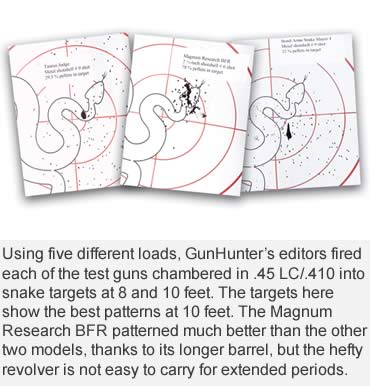Shotshell-loaded pistols are the bee’s knees in poisonous-snake country.
The unseasonably warm South Texas weather slowed deer hunting to a crawl. With only 15 minutes of daylight and a 30-minute walk back to the truck, I left my blind a little early. I was sweating, and little gnats swarmed around my face. I brushed them away in aggravation as I walked along a well-worn cow path that cut through the prickly pear cactus and mesquite brush. I had walked in on that same trail and other than a few cottontails bouncing in and out of the brush, I hadn’t seen living thing.
As I swatted the gnats from my eyes, I slipped in full stride, losing my balance and nearly falling headlong onto the ground. Somehow I managed to find my balance and righted myself. I looked down at my boots, expecting that I’d stepped in a fresh cow pie and slipped. To my surprise, there was no cow manure on my boot soles. What the heck had I slipped on, anyway? I looked behind me and saw the source of my slip — a huge diamondback rattlesnake coiled up no more than 15 inches from my legs, preparing to strike! He’d never rattled.
My first instinct was to jump away, which I did with a gallant adrenaline-powered leap, but by then it was getting dark. I fired at him with my deer rifle but missed, and he crawled off unscathed. As the last light of day faded, I realized that I had stepped on the serpent, probably while he was outstretched and sunning himself, and nearly fell right on top of him. Who knows what would have happened if . . .
— Russell Thornberry, 1962
Nothing gets your attention like suddenly finding yourself at arm’s length from a poisonous snake. Sometimes screaming and jumping to record heights works out, and sometimes it doesn’t. Sometimes the issue gets down to you and the snake. I always choose me!
Trying to get your wits about you in such a situation can be tough, especially when armed with a deer rifle or a bow and arrow, neither of which is the best weapon for close-range snake protection. That situation is best served with a shotgun full of bird shot, but more often than not, we aren’t toting a shotgun. One can carry only so many arms afield before needing porters.
 There is a viable option — a handgun in .44/.410 bore. Several manufacturers offer these, ranging from pocket-size derringers to heavy-duty hip guns that demand stout holsters.
There is a viable option — a handgun in .44/.410 bore. Several manufacturers offer these, ranging from pocket-size derringers to heavy-duty hip guns that demand stout holsters.
GunHunter Managing Editor Larry Teague and I decided to put several of these snake charmers to the test so that we could report somewhat scientifically what the user might expect of each gun in a close-range snake fest. Each of the three handguns is chambered in .45 Long Colt, which also accepts .410-bore shotshells and metal shotshells in .45 Long Colt. To compare the handguns’ overall performance, we tested four different shot loads in each gun.
Perhaps the greatest surprise was that more shot doesn’t necessarily mean more pellets in the kill zone. As you will notice, each of the handguns tested put more pellets in the kill zone with No. 6 shot than with No. 8. So more pellets fired isn’t necessarily the end-all, be-all.
Given that no two firearms, even of the same make and model, will duplicate one another in such tests, this experiment offers the reader a worthy general comparison.
As one might expect, the longer the barrel, the greater the percentage of pellets in the target zone.
The trade-off, of course, is size and weight. Our three handguns ranged from 1 1/2 to 4.65 pounds.
Larry and I concluded that each handgun offers worthwhile snake protection at snake-biting range and far exceeds the protective value of screaming and jumping straight up!
This article was published in the August 2008 edition of Buckmasters GunHunter Magazine. Subscribe today to have GunHunter delivered to your home.